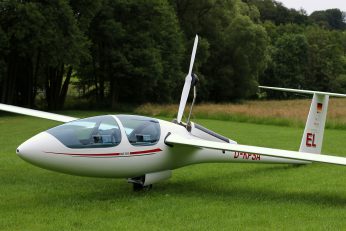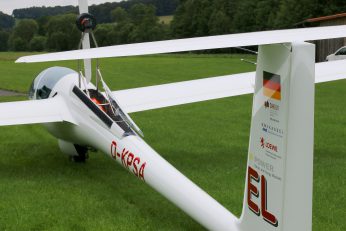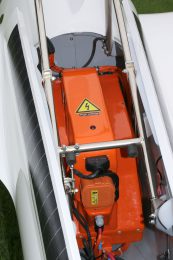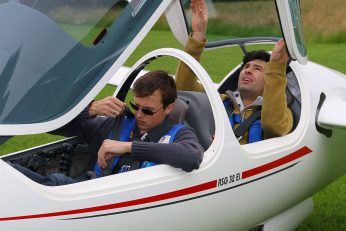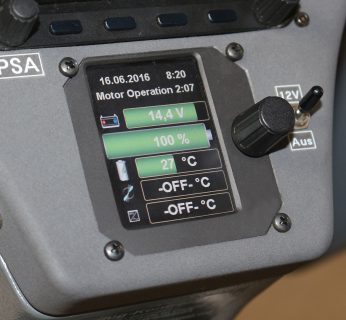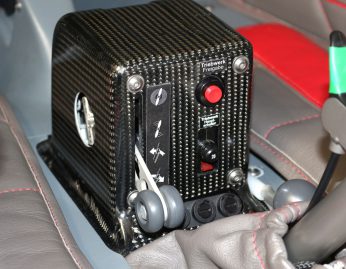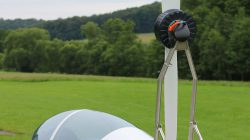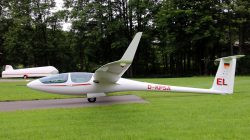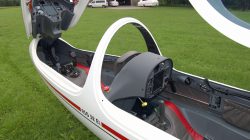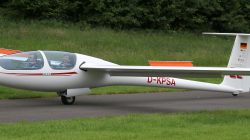ASG 32 EI with electric propulsion is flying now
An environment-friendly sustainer
The electric propulsion system for the ASG 32 EI was first introduced at the AERO exhibition in Friedrichshafen. While the priority last year was to obtain type certification of the Open class ASH 30 Mi as well as the flight testing and type certification of the ASG 32 as a self-launcher and pure sailplane, now the completion of the electric propulsion system has come back into the foreground.
Consortium develops Electric Propulsion System
The 20m two-seater ASG 32 EI with auxiliary engine is the first Alexander Schleicher aircraft to be equipped with an electric propulsion system. This propulsion concept was promoted within the framework of the “Hessen Model Projects” with resources from the provincial offensive for development of scientific-economic excellence (LOEWE).
A Schleicher led consortium including the University of Kassel, the University Baden Württemberg at Mosbach and companies with expertise in battery technology was created for the development process. The propeller and control unit were also developed with expert specialty firms.
100 km Range
After extensive ground runs there was a lot of curiosity to see whether the calculated performance would be confirmed in the air.
A synchronous motor with a performance of 34 BHP (25 kW) is supplied with power from lithium ion cells which are located as a block in fuselage engine compartment. The target was a run-time of 20 minutes under full power. A climb performance of 1.3 m/s (256 ft/min) results in a range of 100 km (62 mi, 54 nm) using the climb and glide method – with two pilots on board.
The advantage of the electric propulsion system is that there is no noticeable climb rate drop as the altitude increases. Naturally, the noise level is also much less inside as well as outside the cockpit compared to combustion engines. Especially on the ground, the noise generated by the ASG 32 EI flying under power is practically absorbed by the ambient noise levels within in the immediate environment.
The day for the first flight came on 16 June 2016. At 11:00 a.m. Dipl. Engineer Paul Anklam and Joschka Schmeisl lifted off in the ASG 32 EI by aerotow in order to get sufficient altitude to verify all the functions of the electric propulsion system. The subsequent extensive climb with a full power confirmed all the previously obtained theoretical values in actual practice. 1,500 m (4,950 ft.) of height were gained within a motor run time of 20 minutes.
Video from the Maiden Flight
Simple Operation
The operation of the propulsion system is understandably simple. A control instrument in the instrument panel provides information about all the important parameters, such as charge status of the batteries, RPM and temperatures.
The engine control unit in front of the stick has an RPM control lever instead of a throttle control. By moving the lever to the first step the motor is extracted. If the lever is moved further up the motor starts and the desired RPM level can be set.
The electric motor is stopped by pulling the lever back. Propeller braking and vertical positioning as well as retraction of the whole propulsion system is carried out automatically.
We are proud to be able to offer an environmentally friendly, comfortable and powerful sustainer system. Even the pure sailplane version of the ASG 32 is series-equipped with an engine compartment into which both the self-launching Wankel propulsion system as well as the future-oriented electro turbo can be fitted. Retro-fitting the sailplane with either of these systems can therefore be achieved without difficulty.
Photos: M. Münch

